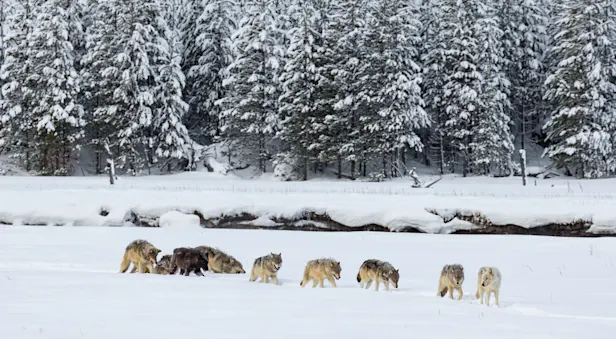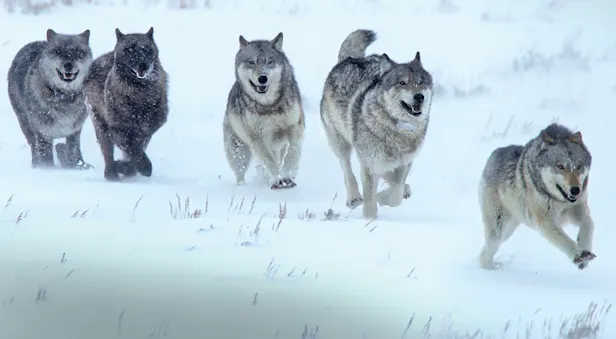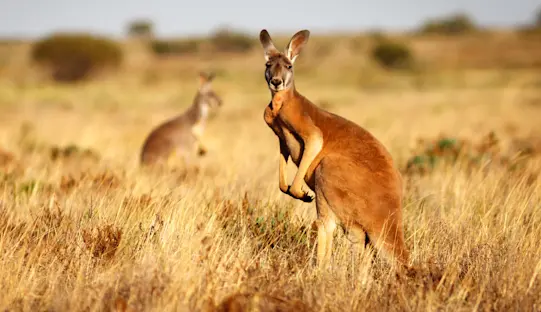
Know Before You Go


Gray Wolf Facts | Yellowstone Wildlife Guide
According to the 2016 Yellowstone Wolf Project Report, the park is home to approximately 100 wolves in 11 packs. This is less than the wolves’ post-reintroduction peak of 175 in the mid-2000s. Biologists believe the current number more accurately reflects the carrying capacity of the park now that the elk population has been brought back into balance by the wolves. The wolf population in the Greater Yellowstone Ecosystem is just over 500.
Thousands of years ago, wolves were the most widely distributed mammal on the planet. Even in 2018, following active persecution by humans, gray wolves (Canis lupus) and their 37 subspecies are found in more than 50 countries throughout North America, Europe, Asia, Africa and Australia, and that does not even include the domestic dog (Canis lupus familiaris), which is ubiquitous anywhere that people live.
From a distance, wolves might appear similar to a large husky or an Alaskan malamute. However, up close you realize they are far larger and more powerful than your faithful companion. A gray wolf can weigh as much as 165 pounds, although the average is closer to 100 pounds. The body of a wolf from nose to tail is 5 to 6.5 feet in length. At shoulder height, they can be 2 to 3 feet tall.
If you are reading this and aren’t impressed because you are thinking about your friend’s Bullmastiff that weighs in at 150 pounds, let’s put the bite strength into perspective. Humans can bite down at about 120–150 pounds per square inch. The mastiff, a massive animal with one of the strongest bites of any domestic dog, can bite with a strength of about 500 psi. Gray wolves, having evolved to take down prey many times their own size, have an impressive bite of more than 1,200 psi!
Wolves are not only built for hunting, however. They are also perfectly designed for travel. Their long legs and streamlined bodies allow them to trot for hours at a steady pace and cover up to 120 miles in a day. Their normal cruising speed is about 5 miles per hour, but in the final moments of a hunt they can sprint at 45 miles per hour. (As a general rule of thumb, never assume you can outrun any wild animal!)
Their coloration can vary widely, even within a single litter. In the Yellowstone area, you may find wolves that are gray, mottled gray and black, and even completely black. Wolves have both a fur undercoat and an overcoat. The thick undercoat traps heat, which helps wolves regulate their body temperature. The overcoat consists of hollow and coarse insulative hairs. This combination of layers enables the wolves to stay active throughout the freezing Yellowstone winter.
WOLF SOCIETY AND COMMUNICATION
Many of the interactions we can observe in a wolf pack are familiar to anyone who grew up in a family. Intra-pack relations are characterized by play, affection and cooperation. While there are occasional challenges for dominance, there is little to be gained—and much to be lost—in conflicts between pack members. In fact, much of the vocal and nonvocal communication that happens within the pack is used to avoid conflict and increase pack cohesion. The very survival of each member depends on how well the entire pack works together.
Also, like human families, every pack is different. Wolves are highly intelligent animals, and each individual and each pack has a distinct personality. The information below relates the most commonly observed dynamics, but to truly understand the unique nature of a specific pack takes years of study.
Wolf packs in Yellowstone average 10 members; the largest pack ever recorded was Yellowstone’s Druid Peak Pack, which had 37 members in 2001. Prey availability, as well as the number of wolves that can live together without excessive conflict determines pack size. Apparently, the Druid Peak Pack pushed this limit, as it ultimately broke up into four separate packs.
The “alpha” male and female are the most dominant wolves in the pack and are generally the only ones who will mate, although occasionally lower-ranking males will mate with the alpha female. Also, at times, a young male will be adopted into the pack to breed with lower-ranking females, bringing in new genes. Again, this depends on the personality of the alpha male, as some are more tolerant than others of this behavior. In Yellowstone, approximately one-quarter of the packs have multiple mating pairs, perhaps related to the abundance of prey.
The alphas usually eat first, determine when and where the pack will move, and direct the strategies used during hunts. In most packs the alpha male is the highest-ranking, although in some packs the alpha female takes this role. Sexually mature adults that are a few years old occupy the next layer in the hierarchy. New pups are at the bottom of the hierarchy, but they quickly establish their own pecking order when nursing and, later, when feeding on kills brought back by the adults. Lower-ranking wolves will regularly engage in submissive displays to assure higher-ranking wolves that they are not a threat to their status until they are ready to make a serious attempt to move up in rank.
The overall hierarchy of a pack is in constant flux, with individuals regularly moving up or down in status. Often this movement is within the lower rungs of the pack, but occasionally a subordinate male will challenge the alpha for control. If the usurper wins, the previous alpha will generally leave the pack to begin a new one elsewhere. If the attempt is unsuccessful, the challenger will most likely be forced to leave. This is an important process, as these “dispersers” spread their genes to new areas.
TERRITORIES
Wolf packs are fiercely defensive of their territories, which range in size from 30 to 2,500 square miles. In Yellowstone, the average territory size is 165 square miles overall, with territories in the northern section of the park being about one-third the size of the ranges in the interior of the park. This is likely due to the concentration of elk in the north, since the size of a pack’s territory is directly related to prey availability.
Most wolf-wolf killings happen on the shared boundary of two territories and are assumed to be the result of defending that boundary. Older dispersing males will also frequently be attacked and killed if they wander into an occupied territory.

Map Source: National Park Service
VOCALIZATIONS
Is there any sound in nature more haunting than the howl of a wolf?
Communication is very important both within and between packs, and while wolves use many forms of communication, the howl is the one that we, as humans, are most familiar with. While we can’t know for sure what inspires a wolf to howl, they seem to do it to reconnect with separated members of their pack, to announce their presence to neighboring packs, to celebrate or coordinate a hunt, and sometimes just because another wolf howled and they can’t seem to resist.
A single wolf usually instigates the howl, and then others join in at different pitches. Alphas tend to howl more frequently than subordinate wolves. The howl is an effective form of long-range communication, as it can travel more than 6 miles in forested areas and almost 10 miles in open areas.
Wolves also have a repertoire of growls, squeaks, yips and barks that round out their vocal communications. Young pups most frequently use these sounds, but sometimes the sounds also accentuate a reunion between wolves that have been separated.
SCENT MARKING
Aggressive encounters between wolves are dangerous for any animals involved, so when possible, these situations are avoided. Scent marking is one of the ways that wolves define their territory without needing to physically chase other wolves out. By leaving “pee-mail” messages at prominent spots such as trail crossings and high points, a dominant wolf is alerting any trespassing wolves to his presence and his territory’s boundaries. This gives the offending wolf the option of leaving the territory if he is not seeking a fight.
A urine scent mark can also convey whether a female is sexually receptive, whether a young male is experiencing high levels of testosterone and thus might pose a threat to the alpha male, or even if an individual wolf in the pack is sick.
Wolves also have scent glands between their toes, the tops of their tails, adjacent to the anus and near their cheeks. Not much is known about the purpose of all of these, but it is likely that they are used in identification of health, rank and reproductive status.
It is logical that olfactory cues are important forms of communication for animals with such a well-developed sense of smell. It is estimated that a wolf’s sense of smell is 100 times greater than that of a human and that wolves can smell prey more than a mile and a half away. However, where the wolf’s nose is truly impressive is in its discernment. Whereas a human might have a general sense of “the smell of spring” or “decaying leaves,” wolves are most likely picking out dozens if not hundreds of individual scents within that.
HUNTING TECHNIQUES
The gray wolf is both predator and scavenger. Despite their power, wolves cannot kill large prey alone. They must hunt in packs, using sophisticated and coordinated strategies that likely served as models for early human hunters. The primary large prey for wolves in Yellowstone is elk, although wolves will also hunt moose, deer and bison. In the winter, elk provide more than 95 percent of their food, and in the summer, elk comprise approximately 85 percent. However, when the elk population drops and the bison population increases, park staff have recorded more bison kills.
Wolves enhance the health of prey species by controlling their populations and hunting the weak, old and immature. In order to identify these weaker individuals, they will charge into a herd and see who begins to fall behind. They will then position themselves in a way that separates the target out from the rest of the herd.
An average pack kills an elk approximately every two to three days, but wolves can go for weeks without eating when prey is scarce. Not knowing when their next meal might come, wolves can eat more than 20 pounds of meat in a single meal.
Packs break into smaller groups during the summer, when prey is more bountiful, and the mating season is forthcoming. Wolves alone or in pairs will hunt smaller prey such as beavers, rabbits and rodents, in addition to scavenging. They may also eat livestock when it is available, leading to conflicts with ranchers.
BREEDING
In Yellowstone, breeding generally occurs in February, with pups born in April. As breeding season gets close, the alpha male and female will increase the amount of time they spend together, and decrease the amount of physical space between themselves when resting and sleeping.
After mating, the female creates a den in which to raise her young. This is a moment of great responsibility for the alpha female, for the pack will need to hunt in that general area until the pups are old enough to travel. If she chooses a denning site that is far from prey, the extra distance required for hunting forays will put additional strain on the entire pack. The den is often dug underground, with a 10- to 30-foot entrance leading to an elevated platform (to avoid flooding), where the pups will be born and remain for several weeks. Dens are also constructed under cliffs, under fallen trees and in caves.
The gestation period for gray wolves lasts between 60 and 63 days, and the average litter size in Yellowstone is 4.4 pups. Once born, the pups are cared for by all of the adult members of the pack.
YOUNG
Born blind and deaf and weighing only 1 pound, wolf pups are completely dependent on their mother for warmth and sustenance. However, at 10 to 15 days of age, the pups have grown significantly, weighing 4 pounds, and their blue eyes open for the first time. These youngsters are only able to crawl, as their back legs are not yet fully functional. Five to 10 days later, the pups can stand and walk. Sometime between the 20th and the 77th day, the pups will leave the den for the first time under the watchful eye of their mother and learn to play fight, which determines the ultimate pup dominance hierarchy.
By six months of age, healthy pups can weigh 60 pounds and are able to travel and hunt with the pack. Most pups will stay with the pack for at least one to four years, and some stay in their original pack for life.
LIFESPAN
The average lifespan for a wolf in Yellowstone National Park is four to five years, and outside the park it is two to three years. The oldest wild wolves might reach an age of 12 or 13 years, but this is rare. Highlighting the value of protection in a national park, 77 percent of wolf mortality inside the park is from natural causes, and outside the park in the Greater Yellowstone Ecosystem, 77 percent of deaths are human caused.
See Yellowstone's Wolves on These Winter Trips

Ultimate Winter Yellowstone: Wolves & Wildlife
Track elusive wolves plus abundant bison, elk, moose and other wildlife, and witness geothermal phenomena amid the snowy splendor of Yellowstone and Grand Teton national parks.


Winter Yellowstone & Grand Teton Photo Expedition
Capture frosty wildlife images in winter solitude in Yellowstone and Grand Teton—go deep into the silent wilds by snowcoach, shoot dramatic landscapes, and photograph roaming elk in Jackson Hole.































